Roar of the crowd: Telegenic on running a sound operation for UEFA at Euro 2020
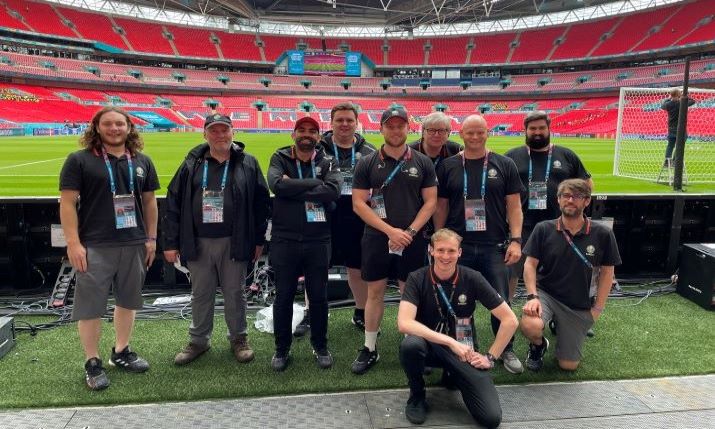
Telegenic’s London sound team at Wembley for UEFA Euro 2020
With the final of Euro 2020 now concluded at Wembley, Telegenic, which is providing unilateral and match services for UEFA via HBS for Rome and Italy, worked at maximum capacity to bring both the sights and sounds of this thrilling event to screens across the globe.
In Rome and London, Telegenic provided UEFA with a multilateral truck, a unilateral truck that is also the emergency truck working with the rights-holding broadcasters, including managing audio for eight stand up positions throughout the venue that broadcasters can book, plus a fully equipped dedicated unilateral service (FEDUS) of two additional OB vans.
Also, as there were two back-to-back semi-finals at Wembley on 6 and 7 July, Telegenic provided an additional OB van for the match day minus-one (MD-1) operations.
“There’s so much resilience built into this [production] from the talkback to the microphones, to having two trucks in terms of UEFA requirements, and then we build our additional layers and protocols on top of that. In the event of an equipment or truck failure scenarios, the audio team know what to do and why in order to keep the show going”
Richard Williams, Telegenic deputy head of sound, says: “For a normal game this is covered from the multilateral truck but the day before England versus Denmark, we covered the training and press conferences from this van so as to allow the main trucks to concentrate on the Spain versus Italy game.”
Parent company EMG provided a fan truck in all Euro 2020 venues to create the pre-match entertainment output for the big screens in-stadium as well as corporate boxes. As part of that contract, Telegenic was also asked to provide fan facilities plus crew in three venues – Dublin (subsequently cancelled and staff reallocated), Rome, and Glasgow, where a smaller OB which is normally used for Premier League Productions coverage was used.
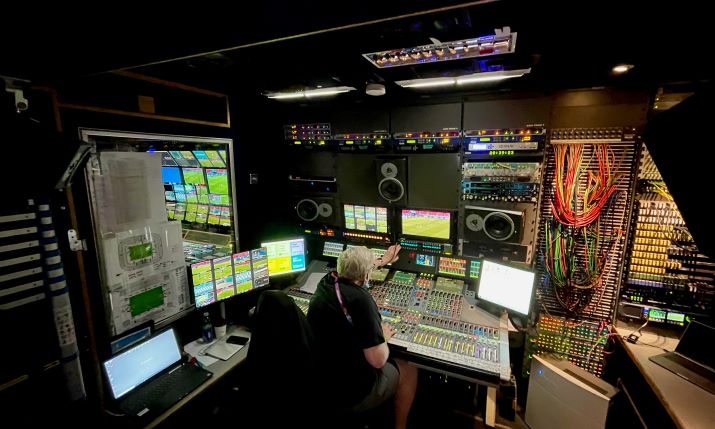
Telegenic match supervisor, Scott Camlin, at the Calrec Apollo desk at Wembley for Euro 2020
Evolving plans
In January 2020 the Telegenic audio team had started to pull together their plans for Euro 2020 on spreadsheets. When the pandemic hit and the Euros were cancelled, “everything for this tournament got pushed onto a back burner while we dealt with other contracts last year,” says David Latham, Telegenic senior sound guarantee.
Adds Williams: “So it feels like this has been like 18 months in the making!”
Speaking to SVG Europe, Latham notes: “In terms of the technical side of things, we were virtually there in planning this and as we got to March last year we were just ramping up everything. For HBS, it’s roughly the same plan [this year] as the 2018 World Cup; the feeds that leave the truck are the same. It’s a big audio template that they just kind of shift on from event to event. So in terms of planning, we kind of took what we did in 2018, and took a little bit of what we did in 2019 at the Women’s World Cup.
“But coming back [to it in 2021] there’s been a lot of logistics we’ve had to sort out, like hundreds and hundreds of ear pieces and other things to make the event COVID-safe, and other things that took up a disproportionate amount of our time with the planning. Otherwise, the main plan didn’t change an awful lot from March 2020.”
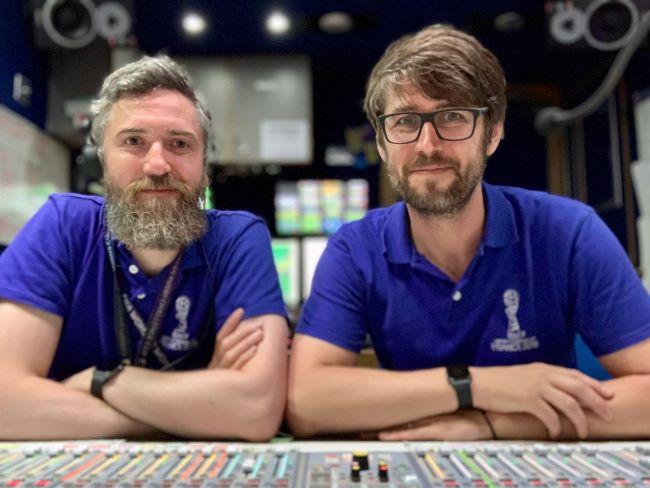
Telegenic’s David (Frank) Latham and Richard Williams, seen here at the 2019 FIFA Women’s World Cup
Keeping video and audio tight
Williams tells SVG Europe about the challenges for the host broadcast audio set up in London and Rome: “Some of the biggest changes have actually been on the video side of the production as the feeds are now produced in a variety of formats including UHD and HDR. This has meant a closer integration between the multilateral and unilateral/emergency trucks in terms of intercom. We connect the two intercom frames to make one integrated frame, which is a regular occurrence for us during the regular season, but a first on the Euros. This means (as cameras are split across the two trucks,) that camera switching between the match director, tactical director and ceremonies director is seamless.”
He goes on: “The number of video formats has increased considerably [at this year’s Euros]. A few years ago everything was 1080i25 and now the vision mixer runs in three levels: 1080p50 SDR, 1080p50 HDR and UHD HDR (HLG). In addition we distribute a number of feeds in 1080i25. It’s a different format of HDR to what we do on a weekly basis for BT Sport and for UEFA Champions League and Europa Leagues.
“We capture in UHD HDR SLOG and broadcast in UHD HDR PQ for BT Sport; Richard Delaney our deputy head of vision at Wembley, and Patrick Harvey, one of our senior video engineers in Rome, have masterminded this multi-layered video operation on our behalf.”
UEFA is capturing the audio on site via the Telegenic truck in 5.1.4. Says Williams: “We mix it on site in 5.1, then we send a lot of these mics and submixes to the IBC [where an] immersive mix is made, which goes with the UHD HDR pictures.
“There are five match feeds, four team or player-specific feeds, and lots of individual cameras, most of which have individual mixes or discrete audio on them,” Williams continues. “We create TVIS – TV International Sound – in Stereo and 5.1, RIS – Radio International Sound in Stereo – a commentary mix on the Calrec Apollo and the tactical mix on the Calrec Brio, in addition to a number of other mixes. Everything leaves discrete and embedded apart from the satellite world feed, which is the only circuit to contain Dolby E.”
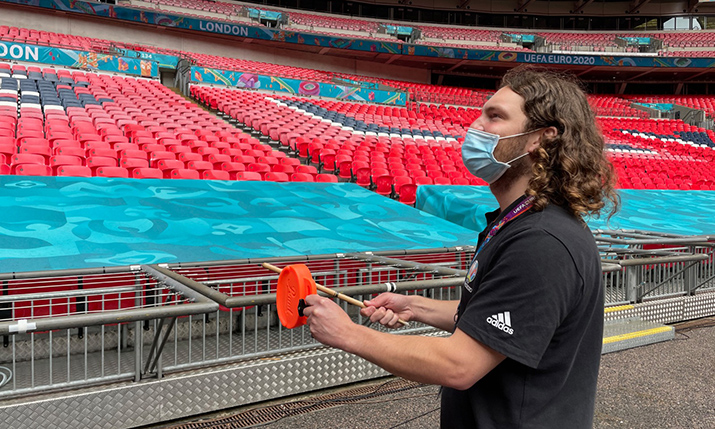
Telegenic A2, Dominic Guest, using percussion to measure delays between mics at Wembley in the run up to Euro 2020
Getting immersive
Williams explains the microphone set up at Wembley: “In terms of audio, the immersive microphone set up has gone up a level with height elements to all of the crowd microphones. The main central crowd microphones is a Schoeps ORTF 3D containing eight capsules, four lower and four for height, which at Wembley we’ve hung high up above the crowd on the walkway under the roof. The left, right and reverse crowd microphones used to be ORTF Pairs; now they’re double ORTF Pairs, in one basket. One pair faces the crowd and the second pair points higher and is used for the height in the immersive mix which is done at IBC.
“The immersive mix is then distributed on the UHD offerings with additional objects including commentary, close ball FX, audio follow video FX. In total I counted 78 capsules capturing the audio for TV and multichannel international sound and we’re adding some more for the final,” he notes.
Williams continues: “We’re using RTS Telex IP talkback panels this time as our trucks all now have an IP audio layer now. We’ve got the EVS cabins on the IP talkback network, which makes that a lot easier, rather than having 20 or 30 individual Cat5 Cables in there; now we’ve just got a switch in there with two fibres and we distribute the panels from there.”
Mad for MADI
Williams continues: “There’s a lot more MADI involved this year; one of the cool things is UEFA have contracted Riedel to provide stageboxes around the venue for us which form a resilient, redundant network. We put the mics into them in pre-allocated order and have control of the mic gains. All the mics then go to the OB trucks on main and backup MADI streams and also to IBC [in Amsterdam] on the IP pipe.
“If there’s a problem with MADI I can switch between the main and redundant MADI inputs using one button on the Calrec Apollo with linked gain, so it’s pretty seamless [in the multilateral truck] . It’s the same on the emergency truck, where the desk is identical in every way. If the multilateral match truck has an issue or the Calrec gets switched off, the technical operating centre (TOC) just switches circuits from the multi truck to the emergency truck to the IBC,” says Williams.
Telegenic was on site at Wembley 10 days before the tournament began, facing the challenge of setting up the hugely resilient audio network. Explains Latham: “The 10 days of rigging when we got on site is building this stuff, and a lot of the head-scratching was trying to make it all work; essentially it’s just a football match with a handful of cameras and the few mics, but the kind of the resilience [it required meant] a lot of time doing late nights to make it run smoothly when things go wrong but hopefully things don’t go wrong.”
Adds Williams: “There’s so much resilience built into this [production] from the talkback to the microphones, to having two trucks in terms of UEFA requirements, and then we build our additional layers and protocols on top of that. In the event of an equipment or truck failure scenarios, the audio team know what to do and why in order to keep the show going.”
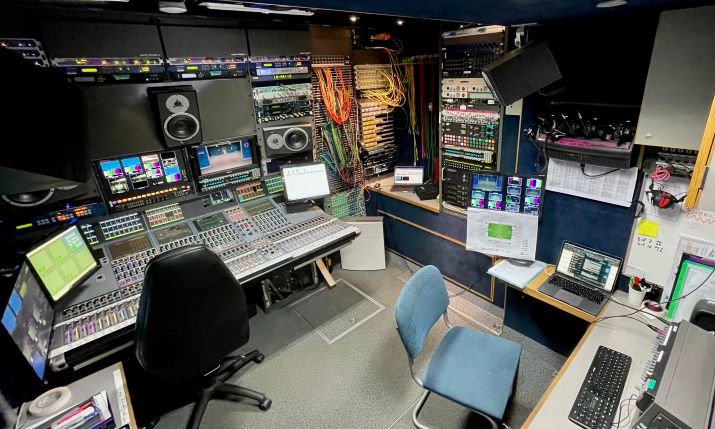
The Telegenic multilateral truck sound area in London’s Wembley for Euro 2020
Taking control of tactical
Latham comments on another new development for audio at this year’s Euros. “One new aspect of our audio plan that we’ve not done at previous events but we have done this year for the Euros involved the Calrec consoles at both venues (we did two in Rome but one was for FEDUS and one was for tactical). I networked some Calrec Brio consoles into the main Calrec Apollo consoles, which is something that hadn’t been done by us in previous events.
“At the Euros we have an outgoing vision circuit called the tactical feed,” Latham explains. “This, amongst other things, takes things like multilateral post-match interviews and press conferences away from the main multi sound supervisor to allow him to concentrate on the main live stadium feed.”
Continues Williams: “Basically all interviews pre and post go through this desk. It really deals with all spoken word content whilst the match desk deals with crowd, close ball sounds, etc. It can be very busy post-match as there may be three interviews going on simultaneously, so the supervisor needs to be well prepared and calm. In London we have the cool hands of Matt Gilbert who would normally be found mixing presentation on the BT Sport Football.
“In previous years the tactical had an audio mixing console that we just fed with MADI,” Williams goes on. “This year we’ve been able to network the smaller Calrec Brio console into the core of the Calrec Apollo that’s doing the main coverage. Using Calrec Hydra Patch Bays we could use any of the Apollo’s resources, which is obviously a much more powerful console, so it allows us to get things like external Hydra stage boxes, MADI, or de-embedders or even our entire analogue jackfield; anything that’s connected to the main Apollo but can be used without having to patch.”
He continues: “It also means that the tactical outputs left via the main Apollo outputs busses, which was convenient in terms of populating our tactical transmission embedders but also offered a layer of redundancy that we didnt have with the dumb MADI tactical desk.”
In previous years the host broadcaster would have sent amplified prefade outputs of the stageboxes to the tactical desk on MADI. Using the networked Brio, however, the operator can change the gain in the stage box mic amps themselves, and not just use make up gain.
Notes Williams: “It really allowed us to take advantage of the much more powerful console and put aspects of the production such as gain control into the hands of the operator who’s actually looking after it and took a bit of the workload off of the multi senior audio engineer and supervisor as well. If you do that on MADI it’s a dumb audio stream; you don’t have any of that control, but this [new set up] helps us make the most of the resources that we had on site via the main Apollo desk.”
No flip-flopping hardships
One last-minute change to UEFA’s Euro 2020 plans – taking European crews moving between two venues each, to the final plan where each crew was tied to a single venue – has been a positive amendment in the long run, says Latham.
He explains: “To be honest with you, flip-flopping [between venues] can be quite arduous for some of the guys as there’s some long days involved. I think it worked out ok having a stationary crew. I did the opening ceremony and the first game, so for the crew to go from that, finishing really late, to the next venue would have been difficult.
“So from that respect, that was quite good and didn’t add any hardship for us,” Latham continues. “Although it probably did for Richard, who sourced the staff and freelance crew we had, and you had to double the amount [when plans changed]; you really want your best guys on events of this level, so Richard had to really work very hard to ensure we had the best guys possible across two venues [London and Rome], which he did, because all the guys we had have been fantastic.”
Williams comments on the crewing process: “Because I have to see the guys on a daily basis, I wanted to pick people who have done this before, know the drill, and also as we have to live together for six or seven weeks, trying to pick a team that will knit well together, and also having a good mix of guys as well, so bringing people through that wouldn’t necessarily have been in a venue this size before to get this great experience.”
Adding one further complication in staffing for Williams has been the Olympics, which due to further pandemic issues has required staff to fly out to Japan earlier than expected, creating an overlap in commitments for some key crew members which needed to be managed.
Yet with meticulous planning, as used throughout Euro 2020, this and every other challenge – and there have been many – have been firmly and efficiently dealt with.
Now, onto the final!
Watch the UEFA Euro 2020 Final between England and Italy on Sunday 11 July at 8pm (UK time) on all rights-holding broadcaster channels
